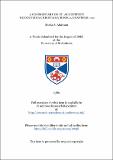Files in this item
A commentary on St. Augustine's De Doctrina Christiana book 2, chapters 1-40
Item metadata
| dc.contributor.advisor | Ogilvie, R. M. (Robert Maxwell) | |
| dc.contributor.author | Atkinson, Sheila Anne | |
| dc.coverage.spatial | 228 p. | en_US |
| dc.date.accessioned | 2019-05-03T10:20:39Z | |
| dc.date.available | 2019-05-03T10:20:39Z | |
| dc.date.issued | 1980 | |
| dc.identifier.uri | https://hdl.handle.net/10023/17638 | |
| dc.description.abstract | The aim of the introduction and commentary is to explore the nature of the work, its sources and originality and the relationship of its pagan and Christian background, in addition to elucidating the text on certain points of content and language. The thesis is not, therefore, primarily a philological commentary. The introduction (including the supplement) consists of seven sections: A. The Date of the De Doctrina Christiana B. The Place of the De Doctrina Christiana in Augustine's Thought C. Augustine, Patristic Exegesis and the De Doctrina Christiana 1. The Aim of the De Doctrina Christiana 2. Augustine's Theory of Signs 3. Language 4. The Manuscripts The conclusions are: A. Books 1.3-3.35 were written in 396/7 and books 3.35 - end of 4 in 426/7. The prologue was probably written in 396/7. B. It was quite natural for Augustine to begin writing on biblical interpretation and its presentation in 396/7 with his renewed interest in Scripture and to complete the work in his old age on discovering it unfinished. C. Augustine follows the general patristic approach to exegesis whereby Scripture is interpreted literally and figuratively. The D.C. does not provide a formal source for the mediaeval concept of the 'Four Senses' of Scripture. 1. The work is aimed at anyone involved in the serious study of Scripture and the proclamation of the Gospel. 2. The theory of signs indicates that in terms of structure the work is typical of technical treatises in antiquity. As regards content of the theory, there are various similarities with classical authors: but, although none of these provide a basis for the whole theory, the relationship to the works of Varro is such that it seems a more adequate solution to posit the final part of his De Lingua Latina as a major source, rather than follow the line of other scholars who credit Augustine with more originality. 3. The language and style are 'literary' rather than 'popular'. The Christian idiom is most evident in vocabulary, as one would expect, when Augustine is writing about specifically Christian topics. The commentary bears out these findings, showing Augustine making an eclectic choice between pagan and Christian elements to suit his own needs. Section 4 of the introduction warns against paying too close attention to the stemmata of the CC and CSEL editions: contamination is such that any attempt to organise the relationships of the manuscripts must be treated with caution. | en_US |
| dc.language.iso | en | en_US |
| dc.publisher | University of St Andrews | |
| dc.subject.lcc | BR65.A9D7A8 | |
| dc.subject.lcsh | Augustine, Saint, Bishop of Hippo. De doctrina christiana | en |
| dc.title | A commentary on St. Augustine's De Doctrina Christiana book 2, chapters 1-40 | en_US |
| dc.type | Thesis | en_US |
| dc.type.qualificationlevel | Doctoral | en_US |
| dc.type.qualificationname | BPhil Bachelor of Philosophy | en_US |
| dc.publisher.institution | The University of St Andrews | en_US |
This item appears in the following Collection(s)
Items in the St Andrews Research Repository are protected by copyright, with all rights reserved, unless otherwise indicated.

